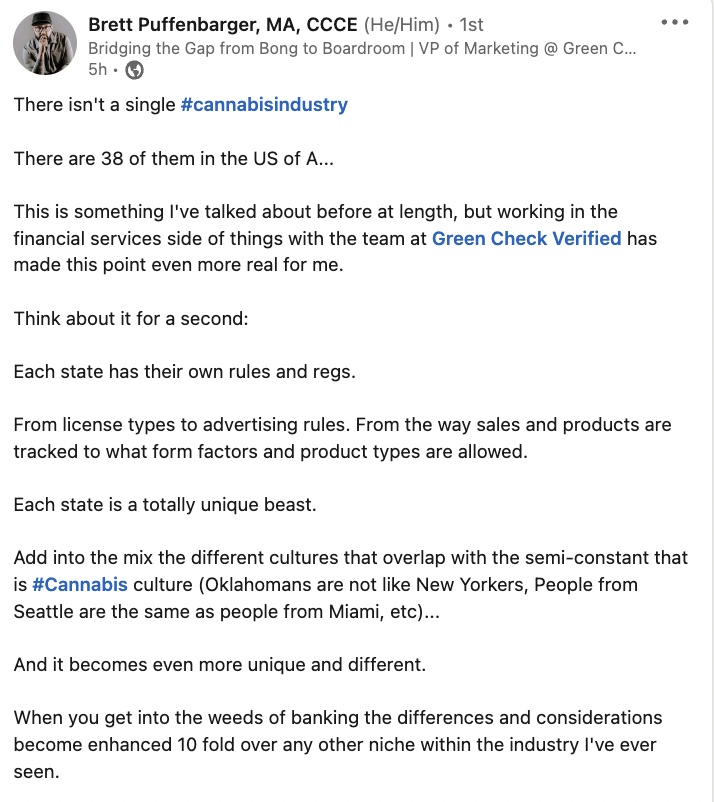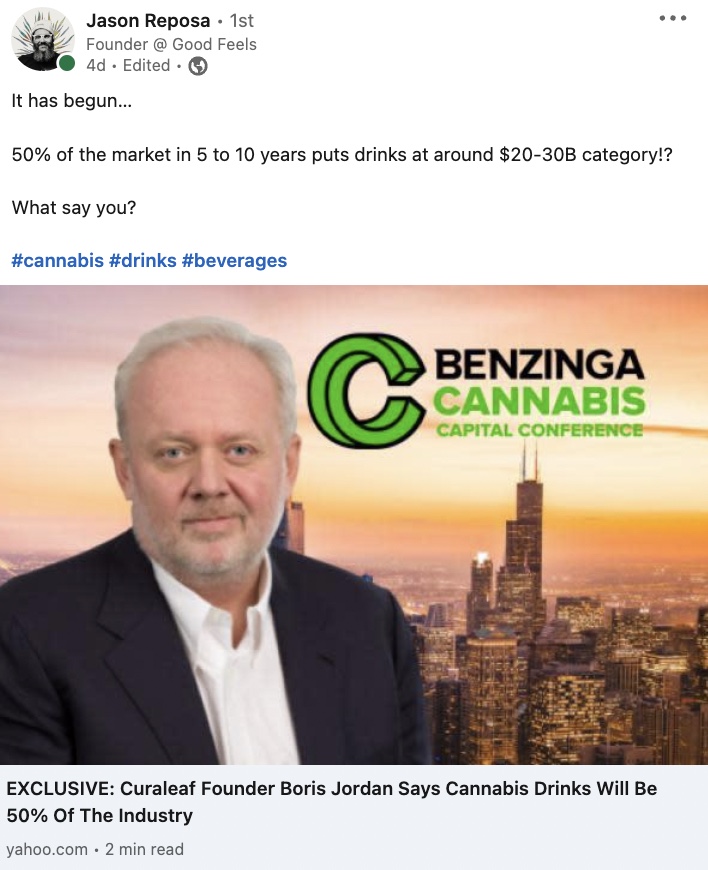20 September 2022 | Cannabis
Our 38 U.S. cannabis industries, the future of cannabis drinks
By Jay
Our 38 U.S. cannabis industries

TLDR: We don’t have one American cannabis industry. We have 38.
I mean – what the heck.
This concept is so freaking simple, I’m almost angry we aren’t talking about it more.
The American cannabis industry, as a collective, has several identical problems: federal restrictions, banking challenges, lack of capital, etc.
But.
The focus is so often on federal challenges that we forget just how much state & local policy dictates local business – meaning each state’s industry looks totally different because of state and local policy.
Take Oklahoma and California, for example. As of June 2021, Oklahoma had 11,636 cannabis businesses. That’s 49 dispensaries for every 100,000 residents.
In California – the nation’s most mature and largest cannabis market – there are 21 dispensaries for every 100,000 people.
California also has a much larger population than Oklahoma, sitting at 40 million compared to Oklahoma’s 4 million per the last census.
This is because of one thing and one thing only: stark differences in state cannabis policy.
Coming back to Brett’s original point: every state has a different cannabis industry. The recipe for success in Oklahoma looks much different than in California.
Throw in the culture – which is a vital part of a hyper local industry like cannabis (and to cannabis consumers in general who care deeply about keeping the culture in legal cannabis) and you’ve got almost 40 different cannabis industries posing as one.
What do we do with that?
Well – we need to start operating like we are 40 separate industries. This is far easier said than done, of course.
I’ve written about the concept of micro-industries in cannabis events before. Cannabis events are stale. Niched down, ultra-focused, sector-specific events are the ticket.
We need to take that same approach to general operations. This means as much as we dive deep into federal challenges, operators need to do the same thing with state and local policy.
I’ll be the first to say that I know the federal restrictions better than I know Missouri’s state restrictions: and that’s not good.
Granted, I’m not a plant-touching operator in Missouri, I just live here and consider myself fairly involved with the local industry.
But imagine if everyone did understand state and local regulations as we do federal restrictions.
Naturally, I think the industry would start to look more individualized than it does now and we would see a stronger, more sustainable success on the micro level.
This isn’t the first time I’ve heard sentiments like Brett is making, or mine with micro-events.
The industry as a whole is beginning to feel that something has to change – and I think state industries leaning more into themselves instead of federal guidelines and gunning for that change is one of those changing things on the horizon.
I know I’ll be taking far more time to learn individual state policies from this point forward.
The future of cannabis beverages

TLDR: I don’t think drinks will make up 50% of the market any time soon. But – they are on the verge of something powerful.
I have a peculiar relationship with the cannabis beverage category.
At one point, I didn’t even consider it a viable category. I barely paid attention to it, because flower. 🤷♀️
Conversations and refocusing my perspective changed my opinion on the cannabis beverage category.
In Canada, the infused beverage category’s market share has grown 850% since 2020, according to a recent Headset report.
And though the category’s success is smaller in the States, 4% of American cannabis consumers prefer cannabis beverages over other form factors.
With 4.7 million consumers in the U.S., that’s approximately 188,000 consumers who prefer beverages as their number one product format.
And, 30% of these consumers drink beverages. It’s not their preferred method, but they drink them. That’s 1,410,000 people, using the 4.7 million figure.
That sounds like 🤑 to me.
With that being said: Boris Jordan’s claim of beverages capturing 50% of the total market in 5-10 years is a very bold claim, and one I personally do not see coming to fruition.
Just 4% of the industry’s total American consumers prefer beverages as their first form factor, so the number of consumers would have to significantly increase over the next 5-10 years – on a level that simply doesn’t seem plausible.
I can easily see cannabis beverages making up 25% of the total market, but probably not within 5 years.
5 years ago was 2017 – and we thought the industry would look a lot different in 2022.
What is the future of cannabis drinks?
Just because 50% of the total market doesn’t seem plausible, doesn’t mean the future isn’t insanely bright for cannabis-infused beverages.
Less and less young people are drinking alcohol as the years go on, which gives cannabis-infused beverage brands a niche to capitalize on.
Beverages can be tailored to several types of cannabis consumers, from the casual consumer to the daily consumer who relies on cannabis as medicine.
Companies like Sorse Technology are taking the world of cannabis drink research & development by storm, finding new and improved ways to manufacture, package, and sell cannabis drinks.
(I wrote about Sorse here, I call them the cannabis industry’s secret drink company)
As people move away from alcohol and shift from “cannabis = stoner” to “cannabis = wellness”, there are massive opportunities for cannabis drinks to explode in crazy ways over the next five years.
But drinks capturing 50% of the total market isn’t something I foresee happening anytime soon.
P.S. find me enhancing every beverage known to man with Good Feels’ THC beverage enhancer. It’s my new travel day must-have.